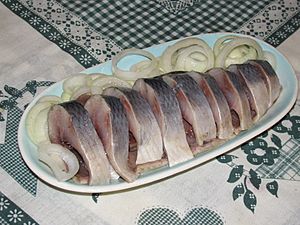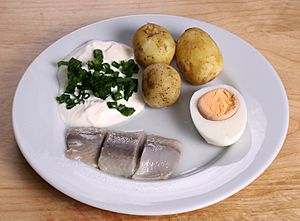Pickled herring facts for kids
Pickled herring is a classic way to keep herring fish fresh for a long time. It involves a process called pickling or curing. This method has been used for hundreds of years to preserve fish.
Usually, making pickled herring involves two main steps. First, the fish is treated with salt. This helps to remove water from the herring. After that, the salt is washed off. Then, the herring is soaked in a special liquid called a brine. This brine is made from vinegar, salt, and sugar. Often, other tasty things are added too, like peppercorns, bay leaves, and fresh onions. Sometimes, people also add sherry, mustard, or dill for extra flavor.
Pickled herring is a very popular food in many parts of Europe. You'll find it in places like Scandinavia, Great Britain, and countries near the Baltic Sea. It's also enjoyed in Eastern and Central Europe, and the Netherlands. In Canada, especially in British Columbia and Newfoundland, it's also a favorite. This dish is also important in Ashkenazi Jewish cooking. It's often served at special gatherings. Pickled herring is one of the traditional dishes for Christmas Eve in countries like Russia, Poland, Lithuania, and Ukraine. Many people also eat it on New Year's Eve. This is a tradition in Poland, the Czech Republic, Germany, and some parts of Scandinavia. It's believed to bring good luck for the new year.
Contents
The History of Pickled Herring
Pickled herring has been a key food in Northern Europe since the Middle Ages. It was a great way to store and move fish. This was especially important during times when people couldn't eat meat, like Lent. The herring would be prepared and then packed into large barrels. This kept them fresh for storage or travel. In 1801, Dutch fishermen who were prisoners of war taught Scottish fishermen how to pickle herring. They used the Dutch method, which was very effective.
Where Pickled Herring is Popular
In the Nordic countries, pickled herring is a very common dish. There are many different flavors, like mustard, onion, garlic, or even lingonberries. People usually eat it with dark rye bread, crisp bread, sour cream, or potatoes. This dish is often served during holidays like Christmas, Easter, and Midsummer. It's sometimes enjoyed with traditional drinks like akvavit.
Different Types of Pickled Herring
Soused herring is a very mild type of pickled herring. It's made from young, small herring. These fish are left to ripen for a few days in oak barrels. They soak in a salty solution called brine. In English, "soused herring" can also mean herring that has been cooked and then marinated.
Rollmops are another fun type of pickled herring. They are fillets of herring that are rolled up. Inside the roll, you'll often find a piece of pickled gherkin (a small cucumber) or an onion. They first became popular in Berlin in the 1800s. The name "Rollmops" comes from the German word.
In the British Isles, people have eaten fish preserved by pickling or salting for a long time. Like jellied eels, it was often eaten by working-class people. Kipper is a dish popular in Great Britain, Ireland, and parts of Canada. It's a herring that has been split open, pickled or salted, and then cold-smoked.
Red herring is similar to kippers but is kept whole. It's salted more heavily and smoked for two to three weeks. The UK mainly sells red herring to Europe and West Africa.
Pickled Herring Around the World
Pickled herring is very common in Russia and Ukraine. It's often served cut into pieces with sunflower oil and onions. It's also a main ingredient in salads, like dressed herring. This salad is known as 'herring under a fur coat' and is made with vegetables and mayonnaise.
Brined herring is also a staple in Ashkenazi Jewish cooking. It's well-known as "chopped herring" or schmaltz herring. In Israel, it's called dag maluach, which means "salted fish."
You can even find pickled herring in the food of Hokkaidō, Japan. Families there traditionally preserved large amounts for the winter months.
In Nova Scotia, Canada, pickled herring with onions is called "Solomon Gundy." This is not the same as the Jamaican dish with the same name.
"Bismarck herring" is a common name for pickled herring in Germany. It's sometimes sold under this name in other places too. There are different stories about why it's named after Otto von Bismarck.
Nutritional Benefits
Pickled herring is a great natural source of important nutrients. It contains both vitamin D3 and omega-3 fatty acids. These are both very good for your health. It's also a good source of selenium and vitamin B12. Just 100 grams of pickled herring can give you a lot of your daily needs for these vitamins and minerals. For example, it can provide 170% of the daily value for vitamin D. It also gives you 84% of the daily value for selenium and 71% for vitamin B12.



